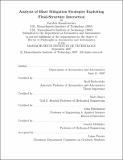| dc.contributor.advisor | Raúl Radovitzky. | en_US |
| dc.contributor.author | Kambouchev, Nayden Dimitrov, 1980- | en_US |
| dc.contributor.other | Massachusetts Institute of Technology. Dept. of Aeronautics and Astronautics. | en_US |
| dc.date.accessioned | 2008-09-02T17:53:59Z | |
| dc.date.available | 2008-09-02T17:53:59Z | |
| dc.date.copyright | 2007 | en_US |
| dc.date.issued | 2007 | en_US |
| dc.identifier.uri | http://hdl.handle.net/1721.1/42045 | |
| dc.description | Thesis (Ph. D.)--Massachusetts Institute of Technology, Dept. of Aeronautics and Astronautics, 2007. | en_US |
| dc.description | This electronic version was submitted by the student author. The certified thesis is available in the Institute Archives and Special Collections. | en_US |
| dc.description | Includes bibliographical references (p. 163-177). | en_US |
| dc.description.abstract | Blast attacks have become the most pervasive threat in both civil and military contexts. However, there is currently a limited understanding of the mechanisms of loading, damage and failure of structures, and injury to humans produced by blast. This thesis seeks to advance our current understanding of the mechanisms of blast loading on structures. Towards this end, a comprehensive analytical and numerical study of basic problems in the interaction of blast waves with structures is conducted. The analysis is of interest in the conception of blast mitigation strategies and in the design and optimization of protection systems with improved performance against blast. The approach builds on a classic solution by G. I. Taylor on the interaction of acoustic blast waves with free-standing plates (In G. K. Batchelor, editor, The Scientific Papers of Sir Georey Ingram Taylor, vol. III, p.287-303, Cambridge University Press, 1963). Taylor's analysis demonstrates that the coupled fluid-structure interaction eect can be exploited for the purpose of reducing the impulse transmitted from the blast to the structure. This basic result is not applicable to the case of air blasts due to non-linear compressibility effects. In this thesis, a number of extensions of Taylor's theory is proposed. The case of air blast waves interacting with free-standing plates of variable mass is given special attention. The limiting cases of extremely heavy and extremely light plates are explored analytically for arbitrary blast intensities, from where it is concluded that a modified non-dimensional parameter representing the mass of compressed fluid relative to the mass of the plate governs the fluid-structure interaction. | en_US |
| dc.description.abstract | (cont.) The intermediate asymptotic regimes are studied using a numerical method based on a Lagrangian formulation of the Euler equations of compressible ow and conventional shock-capturing techniques. Based on the analytical and numerical results, approximate formulae for the transmitted impulse describing the entire range of relevant conditions are proposed. The main conclusion of the theory is that non-linear fluid compressibility further enhances the beneficial effect selects of fluid-structure interaction in reducing the impulse transmitted to the structure. More specifically, it is found that impulse reductions due to fluid-structure interaction are more significant than in the acoustic limit when compared to those obtained ignoring fluid-structure interaction effect selects. In addition, a number of acoustic results for uniform shocks, viscoelastic supports, two fluid media, impulsively deployed and pressure actuated plates are proposed which provide the basis for evaluation of the benefits of the fluid-structure interaction in a wide variety of settings. The governing non-dimensional parameters in each specific context are determined and exact solutions to the fluid-structure interaction problem are provided. The results for the actively deployed plates reveal that significant cancellation of the blast impulse can be achieved thus suggesting a plausible blast mitigation strategy. | en_US |
| dc.description.statementofresponsibility | by Nayden Kambouchev. | en_US |
| dc.format.extent | 177 p. | en_US |
| dc.language.iso | eng | en_US |
| dc.publisher | Massachusetts Institute of Technology | en_US |
| dc.rights | M.I.T. theses are protected by
copyright. They may be viewed from this source for any purpose, but
reproduction or distribution in any format is prohibited without written
permission. See provided URL for inquiries about permission. | en_US |
| dc.rights.uri | http://dspace.mit.edu/handle/1721.1/7582 | en_US |
| dc.subject | Aeronautics and Astronautics. | en_US |
| dc.title | Analysis of blast mitigation strategies exploiting fluid-structure interaction | en_US |
| dc.type | Thesis | en_US |
| dc.description.degree | Ph.D. | en_US |
| dc.contributor.department | Massachusetts Institute of Technology. Department of Aeronautics and Astronautics | |
| dc.identifier.oclc | 228875559 | en_US |
